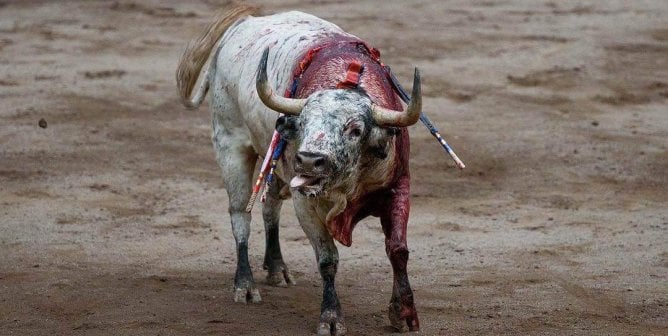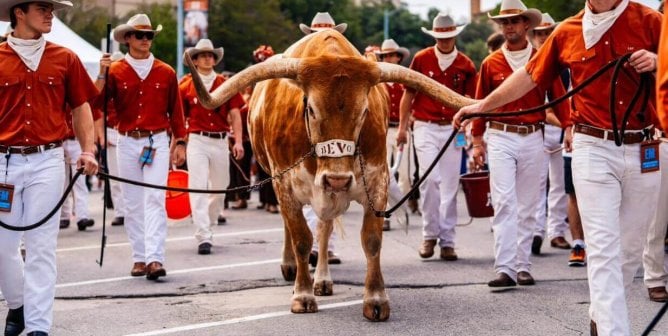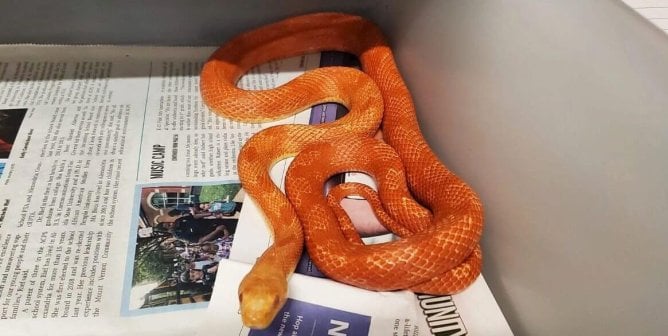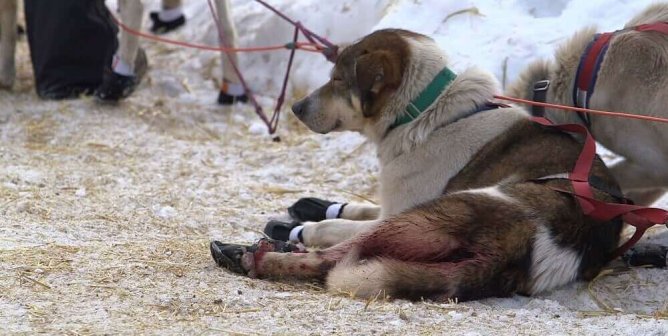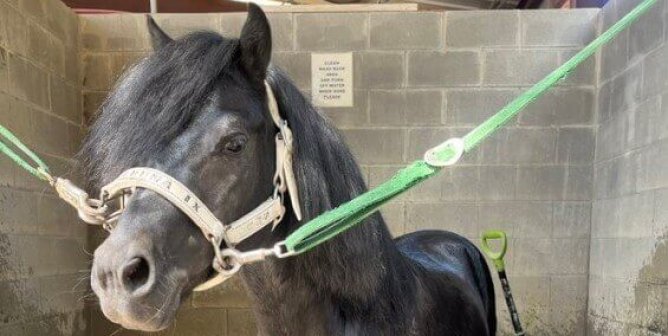Dog-Sled Racing: Death on the Trails
Imagine “racing your dog from Orlando to New York, depriving him of sleep to complete the course as quickly possible, mushing though waist-deep water and ice, with the dog losing about 10 pounds through the ordeal.”1 Or consider tethering yourself “to 15 other runners on a 50-foot gangline while pulling 400 pounds. Imagine flipping on your back and being dragged down an icy incline.”2 That’s how two sports columnists described the Iditarod dog-sled race, a grueling expedition from Anchorage to Nome, Alaska, that takes place every March. It’s one of several such races, in which dog-sled drivers called “mushers” compete for thousands of dollars and other prizes. Meanwhile, the dogs—viewed as little more than snowmobiles with fur—are considered lucky if they finish the race alive and without serious injuries.
The Most Notorious of Races
Hundreds of dogs start the Iditarod, but up to half are “dropped” every year because they become too sick, injured, or exhausted. They’re forced to run for hours through jagged mountain ranges, frozen rivers, dense forests, and desolate tundra in biting winds, blinding snowstorms, and below-freezing temperatures.3,4 The dogs are usually tethered to 400-pound sleds in teams of 12 to 145,6,8 and run about 100 miles per day, with only 40 hours of rest mandated throughout the entire eight- to 10-day race.7,8
The dogs’ feet become bruised and bloodied, cut by ice, and just plain worn out from the tremendous stretch of ground that they cover. Many pull muscles, incur stress fractures, or become sick with intestinal viruses or bleeding stomach ulcers. In his capacity as a volunteer veterinarian for the race, Scott Moore told The Cody Enterprise that he “saw dogs with torn Achilles tendons, dehydration, diarrhea, hypothermia, hyperthermia, inflammation in the wrists, and soreness in shoulders from the harnesses.”9
Orlando Sentinel columnist George Diaz wrote that the Iditarod is “nothing more than a barbaric ritual that gives Alaskan cowboys a license to kill.”10 More than 150 dogs have died running the race, not counting all those who died during the off-season or those who were shot or bludgeoned to death because they lacked the rare speed and stamina to make the grade. The leading cause of death for dogs in the Iditarod is aspiration pneumonia caused by inhaling their own vomit. Five dogs died in 2017 alone.11 In just the last decade, dogs competing in the event have died from various causes, including asphyxiation, heart attacks, freezing, trauma from being struck by a vehicle, and excess fluid in the lungs.12,13 Flash, a 4-year-old dog in musher Katherine Keith’s team, died from acute aspiration pneumonia, which occurs when dogs inhale food, liquid, or vomit into their lungs.14 Smoke, a 2-year-old from musher Scott Smith’s team, died of hypothermia on a plane after being dropped from the race, while Groovy was killed by a car after he escaped a handler.15,16 The estimated Iditarod death rate is 2.9 fatalities for every 1,000 competitors—if the Boston Marathon caused deaths at the same rate, 290 human runners would have died in the races during the 1990s.17
Even if dogs survive a race, they may die afterward. Dr. Paula Kislak, president of the Association of Veterinarians for Animal Rights, has stated, “With a buildup of lactic acid and other chemicals from muscle degradation as a result of extreme exercise, toxicity in the liver and kidneys may not cause death for days or weeks after a race.”18 A study published in the American Journal of Respiratory and Critical Care Medicine found that of 59 dogs who were examined 24 to 48 hours after a race, 81% had “abnormal accumulations” of mucus or cellular debris in their lower airways. Furthermore, the lung damage was classified as moderate to severe in nearly half of the dogs.19
There are other grueling and deadly dog-sled races that aren’t as well publicized, including the Copper Basin 300, the Race to the Sky long-distance races, and the Yukon Quest international race.
Suffering Behind the Scenes
In late 2018 and early 2019, a PETA eyewitness working in Alaska’s dog-sledding industry found that dogs were denied veterinary care for painful injuries, kept constantly chained next to dilapidated boxes and plastic barrels in the bitter cold and biting wind, and forced to run hundreds of miles, despite being exhausted and dehydrated. Visit PETA.org for more information about this investigation.
At Colorado’s Krabloonik Kennels, the largest tourist dog-sledding operation in the U.S., “excess” dogs were routinely shot in the back of the head and buried in a pit. The town’s mayor staunchly defended the operation and brazenly refused to allow advocates to speak at town meetings. Tenacious locals pushed the district attorney to take action, and a surprise inspection resulted in the owner being charged with eight counts of cruelty to animals. The owner sold the operation—which continues today—to like-minded employees.20
Boppy, a dog on musher Hugh Neff’s team, died of aspiration pneumonia during the Yukon Quest. A necropsy revealed that he also suffered from “mild stomach ulcers, moderate intestinal inflammation, mild whipworm infestation, skeletal muscle necrosis, and severe weight loss and muscle wasting.” Veterinarian Kathleen McGill said, “This dog was already in a low-body state, if you will, trying just to keep itself alive without even running a race,” and Neff was banned from the 2019 Iditarod “due to concerns over his lack of dog care.”21,22,23
Profiting From Pain and Misery
Like any other tourist attraction, the motive of the Iditarod and similar races is money. USA Today sportswriter Jon Saraceno, who dubbed the race the “Ihurtadog,” reported, “The economic impact to Anchorage, site of the ceremonial start, is estimated at more than $5 million. … The dogs, of course, get their usual take. More suffering.”25 Saraceno has also written that the race is “shameful marketing carried out on the backs of defenseless animals.”24
Like any other tourist attraction, the Iditarod and similar races are motivated by profit—but public and financial support for the industry is waning. In 2021, ExxonMobil, one of the largest corporate sponsors of the Iditarod, pulled its sponsorship.27 State Farm, Guggenheim Partners, and Wells Fargo also ended their sponsorships of the race shortly after it concluded in March 2017.25 That same year, a documentary by director Fern Levitt called Sled Dogs exposed the ugly, behind-the-scenes cruelty inherent in the dog-sledding industry. Shortly after that, organizers of the race announced numerous budget cuts, including a $250,000 reduction of the following year’s purse.26 Jack Daniel’s, Coca-Cola, Alaska Airlines, and Chrysler also pulled their sponsorships.27,28,29
What You Can Do
Do not patronize the Iditarod or other dog-sled races or tourist attractions that include dog-sled rides. If you’re planning a trip to Alaska, be sure to let your travel agent know that you don’t want any packages that include dog-sled rides. Let sponsors of dog-sled races know you don’t support businesses that endorse such cruelty.
Support human races instead! Similar races are held with willing human participants who run or ski the trail or use snowmobiles. In New York City, the “Idiotarod” features hundreds of human racers who push shopping carts over the Brooklyn Bridge into Manhattan,30 and Phoenix, Arizona, has been running its own “Idiotarod” race since 2007.31
References
1George Diaz, “Iditarod Dog Deaths Unjustifiable,” Orlando Sentinel, 5 Mar. 2000.
2Jon Saraceno, “Grueling Iditarod Not Even Fit for Dogs,” USA Today, 3 Mar. 1999.
3Tegan Hanlon, “Number of Dropped Dogs About ‘Normal’ So Far Despite Cold, Iditarod Veterinarian Says,” Anchorage Daily News, 9 Mar. 2017
4Judy Chia Hui Hsu, “Everything Turns to Mush,” The Seattle Times, 5 Jan. 2005.
5Robin Heubner, “The Iditarod Doc: Local Veterinarian To Mark 18th Year Caring for Sled Dogs at Alaska Race,” West Fargo Pioneer,” 20 Feb. 2018.
6Katie Stark, “A Turbulent Year for The Iditarod Gives Birth to A New Era,” Frontiersman, 7 Jul. 2018.
7Michaeleen Doucleff, “Iditarod Sled Dog Race,” Cell 148(2012): 839-841..
8“Official Rules 2019,” Iditarod Trail International Sled Dog Race, accessed 2 Dec. 2018.
9Jami Badershall, “Cody Veterinarian Gets Kick Out of Iditarod,” The Cody Enterprise, 26 Mar. 2004.
10Diaz.
11Leroy Polk,”Cause of Death Identified for Two Dogs Who Died on the Iditarod Trail,” KTUU, 17 Mar. 2017.
12Jennifer Viegas, “At 2009 Iditarod, Dog Deaths Stir Controversy,” Discovery News, 25 Mar. 2009.
13Yereth Rosen, “Iditarod Ends, Critics Seek Inquiry Into Dog Deaths,” Reuters, 25 Mar. 2009.
14Leroy Polk, “Cause of Death Identified for Two Dogs Who Died on The Iditarod Trail,” KTUU, 17 Mar. 2017.
15“Iditarod Live Blog for Saturday, March 11: Dog That Died in Plane May Have Overheated,” Alaska Dispatch News, 2 Dec. 2017.
16“After Returning to Anchorage, Iditarod Sled Dog Hit by Vehicle and Killed,” KTUU, 13 Mar. 2017.
17Saraceno, “Grueling Iditarod Not Even Fit for Dogs.”
18Bod Padecky, “Victims of Cold, Fatigue, and Greed,” The Press Democrat, 20 Mar. 2004.
19M.S. Davis et al., “Racing Alaskan Sled Dogs as a Model of ‘Ski Asthma,’” American Journal of Respiratory and Critical Care Medicine 166 (2002): 878–82.
20Christopher Osher, “Aspen-area Dog-Sledding Operation Sparks Concerns, Investigation,” the Denver Post, 7 Dec. 2013.
21“Final Necropsy Report on Boppy, Hugh Neff’s Dog,” Yukon Quest, 24 Apr. 2018.
22Tegan Hanlon, “Yukon Quest Bans 2-time Champ from 2019 Race after Examination of Dead Dog,” Anchorage Daily News, 24 Apr. 2018.
23Madeline McGee, “Hugh Neff Barred from 2019 Iditarod Amid Concerns over Dog Care,” Anchorage Daily News, 30 Nov. 2018.
24Yereth Rosen, “Iditarod Sled-dog Race Losing Exxon Support Amid Animal-rights Pressure,” Reuters, 22 Jan. 2021.
25Rachel D’Oro, “Major Sponsor Pulls Support From Alaska’s Iditarod Race,” Associated Press, 25 May 2017.
26Tegan Hanlon, “Cash-strapped Iditarod Cuts Purse for 2018 Race by About $250,000,” Alaska Dispatch News, 22 Sep. 2017.
27Rachel D’Oro, “Longtime Sponsor of Iditarod Cuts ties with Alaska Race,” Associated Press, 27 June 2018.
28Jason Owens, “Dogs Quit on Iditarod Leader When Musher Yells at One of His Animals,” Yahoo News, 11 Mar. 2019.
29Mark Thiessen, “Norwegian Musher Achieves Boyhood Dream, Wins Iditarod Race,” Associated Press, 18 Mar. 2020.
30Ben Yakas, “Idiotarod, The Glorious Annual Gathering Of Costumed Idiots, Happening This Month,” Gothamist, 11 Jan. 2019.
31Benjamin Leatherman,”The Phoenix Idiotarod Is the Best Local Event You’ve Never Heard Of,” Phoenix New Times 4 Feb. 2020.

